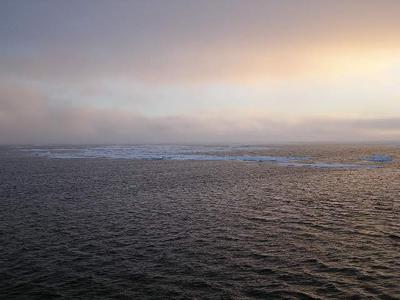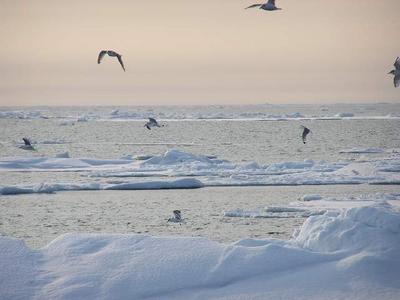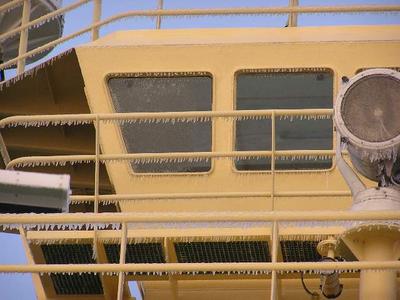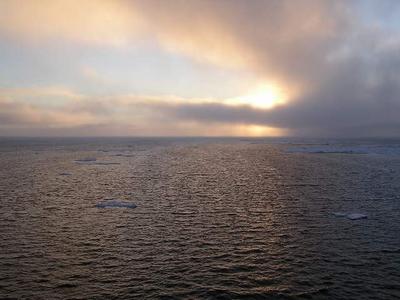13 August, 2003
Chief Scientist's Report #6
R/V Nathaniel B. Palmer SBI Survey Cruise
James H. Swift
13 August 2003, ca. 1:00 pm Alaska time - from R/V Nathaniel B.
Palmer in the Arctic Ocean off the Beaufort shelf
Our SBI cruise continues to go very well. The professionalism of the
officers, crew, and science team, plus the forgiving ice conditions,
have combined to provide rapid progress with our planned work. We
have now completed 299 CTD/rosette stations, setting new
casts-per-cruise records for the ship and all hands.
Our shelf survey sampled two distinct shelf bottom water regimes, one
low in nutrients and high in oxygen, and the other high in nutrients
and low in oxygen. Our overall measurements connected the high oxygen
regime to the Beaufort slope through Barrow Canyon, but there were
several puzzling features about the spatial pattern of the low-oxygen
regime. Partly to better study this regime we embarked on a long
section along the outer shelf from the Russia/US boundary line to
Barrow Canyon, including a crossing of Herald Valley and two spur
sections into the Arctic basin. Indications are that the low-oxygen
signal, which is strongest in the west, spreads east along the outer
shelf, spills into Herald Valley which heads it out along the shelf
edge, then spreads around Hanna Shoal into Barrow Canyon. The
lowered-ADCP data reveal a shelf edge flow supporting these
inferences from water properties. Our earlier deep basin observations
of high-nutrient outer reaches on cold core eddies may indicate one
mechanism which could move these waters away from the slope into the
basin interiors. We followed the shelf section with a rerun of our
earlier Barrow Canyon section closest to SBI current meter arrays.
The plots from this pair of sections shows them clearly as twins, but
to the eye perhaps more nearly fraternal than identical. In sum, this
has been a satisfying week of water chasing.
The three graduate students who are working on the rosette program
(thanks to NSF!) have been doing a terrific job. They run casts, work
in the sampling room, carry out their own research programs, and
still make time to work up property-property plots and vertical
sections comparing the 2003 data to data from the three 2002 SBI
cruises, and excellent plots of the ship's underway data. Together
with Eric Johnson's LADCP plots these will comprise a suite of
interpretative products which should be useful to the SBI science
team.
Weather during the past week began with more of the same
gray-cold-foggy conditions, joined by freezing rain which decorated
the rails with icicles. But there have also been breaks of good
weather.
The marine mammal surveys continue to produce good results, although
unfavorable weather has limited use of the helicopter. Across the
study area, the team observed lower densities of seals than expected,
presumably due to declining haulout rates following the annual
molting period. Consistently high densities of walrus have been
observed hauled out on a band of ice just inside the outer fringe of
the marginal ice zone, where several thousands of walrus were seen
over the past week.
Chance observations of marine life continue. One evening as we were
on station we came across a polar bear - or rather the bear came by -
riding a drifting, isolated chunk of jumbled floes some 30 miles from
the main ice field. The bear appeared to be tired, rising to look at
us only as we passed. Last night our TEA Jim Rogers saw a bear
swimming along in the ocean, many miles from ice or land.
Every now and then the pumps on our CTD ingest some marine life which
fouls the sensors - usually for only a few seconds. Otherwise the
stations just hum along.
We are now repeating one of our long shelf-slope-basin sections which
ran close to another SBI moored array east of Barrow Canyon. The ice
cover has all but disappeared during the month between occupations,
making for brisk progress. Our final goal - a shelf-slope-basin
section east of any yet done for SBI - is in sight.
All is well.

Barrow Canyon from the surface.

Black-legged Kittiwakes often follow the Palmer to snatch Arctic Cod washed up on the ice.

Ice on the Ice Tower.

Day's end over Barrow Canyon.
Contact the TEA in the field at
.
If you cannot connect through your browser, copy the
TEA's e-mail address in the "To:" line of
your favorite e-mail package.
|
